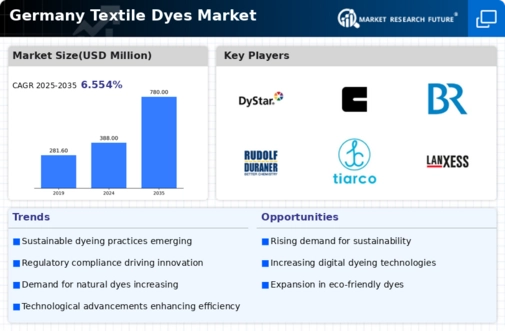The Germany Textile Dyes Market is characterized by a competitive landscape that reflects both a strong domestic presence and the influence of global players in the textile chemical industry. The market is driven by several factors, including the ever-evolving fashion trends, a growing emphasis on sustainable practices, and the rising demand for high-performance textile products among various applications.
Environmental regulations and consumer preference for eco-friendly dyes further stimulate innovation within the sector. Competition is intense as companies strive to differentiate themselves through product offerings, quality, and technological advancements, while also navigating the complexities of regulatory compliance and sustainable manufacturing processes.
With a mixture of established companies and innovative newcomers, the market is dynamic and highly responsive to changes in consumer behavior and industry standards. DyStar has established a strong presence in the Germany Textile Dyes Market, known for its commitment to quality and innovation. The company's expertise lies in providing a broad range of dye solutions that cater to diverse textile applications, such as apparel, home textiles, and industrial fabrics.
DyStar’s strengths include its advanced research and development capabilities, which enable the introduction of sustainable dye products that meet stringent environmental regulations. The company also benefits from a robust supply chain network across Germany, allowing it to efficiently deliver products to its customers while maintaining a focus on service excellence. This commitment to quality, combined with a proactive stance on sustainability, makes DyStar a significant player in the textile dyes market in Germany.
Clariant, another key player in the Germany Textile Dyes Market, has carved a niche through its emphasis on innovative and sustainable solutions for textile manufacturers. The company offers a comprehensive portfolio of products, including reactive dyes, pigment preparations, and specialty chemicals that cater to various demands in the textile ecosystem.
Clariant's strengths lie in its dedication to research and innovation, with ongoing investments in eco-friendly product development and sustainable processes. The company's market presence is bolstered by strategic mergers and acquisitions that allow it to expand its capabilities and product offerings. Additionally, Clariant's well-established relationships with key industry players enhance its competitive positioning in the Germany market.
Their focus on sustainability and performance further underscores their commitment to addressing the needs of modern textile manufacturers, making Clariant a pivotal entity in the landscape of textile dyes in Germany.






















Leave a Comment